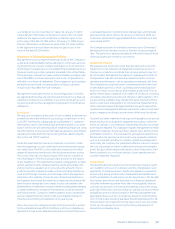Walmart 2009 Annual Report Download - page 37
Download and view the complete annual report
Please find page 37 of the 2009 Walmart annual report below. You can navigate through the pages in the report by either clicking on the pages listed below, or by using the keyword search tool below to find specific information within the annual report.
35Wal-Mart 2009 Annual Report
De nite-lived other acquired intangible assets are considered long-
lived assets and are amortized on a straight-line basis over the periods
that expected economic bene ts will be provided.
Inde nite-lived other acquired intangible assets are evaluated for
impairment based on their fair values using valuation techniques
which are updated annually based on the most recent variables
and assumptions.
Goodwill is evaluated for impairment by determining the fair value of
the related reporting unit. Fair value is measured based on a discounted
cash ow method or relative market-based approach. The analyses
require signi cant management judgment to evaluate the capacity
of an acquired business to perform within projections. Historically,
the Company has generated su cient returns to recover the cost of
the goodwill.
Goodwill is recorded on the balance sheet in the operating segments
as follows:
January 31,
(Amounts in millions) 2009 2008
International
$14,955 $15,574
Sam’s Club 305 305
Total goodwill $15,260 $15,879
The decrease in the International segment’s goodwill since January 31,
2008, primarily resulted from strengthening of the U.S. dollar against
all major currencies except the Japanese yen and an adjustment to
allocate $192 million of goodwill for the sale of Gazeley, an ASDA
commercial property development subsidiary in the United Kingdom,
partially o set by goodwill recorded in connection with the acquisi-
tion of a majority interest in Distribución y Servicio D&S S.A. (“D&S”)
in scal 2009.
Leases
The Company estimates the expected term of a lease by assuming
the exercise of renewal options where an economic penalty exists
that would preclude the abandonment of the lease at the end of the
initial non-cancelable term and the exercise of such renewal is at the
sole discretion of the Company. This expected term is used in the
determination of whether a store lease is a capital or operating lease
and in the calculation of straight-line rent expense. Additionally, the
useful life of leasehold improvements is limited by the expected lease
term or the economic life of the asset. If signi cant expenditures are
made for leasehold improvements late in the expected term of a
lease and renewal is reasonably assumed, the useful life of the lease-
hold improvement is limited to the end of the renewal period or
economic life of the asset, whichever is shorter.
Rent abatements and escalations are considered in the calculation
of minimum lease payments in the Company’s capital lease tests and
in determining straight-line rent expense for operating leases.
Foreign Currency Translation
The assets and liabilities of all foreign subsidiaries are translated using
exchange rates at the balance sheet date. The income statements of
foreign subsidiaries are translated using average exchange rates for
the period. Related translation adjustments are recorded as a compo-
nent of accumulated other comprehensive income.
Revenue Recognition
The Company recognizes sales revenue net of sales taxes and estimated
sales returns at the time it sells merchandise to the customer. Customer
purchases of shopping cards are not recognized as revenue until the
card is redeemed and the customer purchases merchandise by using
the shopping card. The Company also recognizes revenue from service
transactions at the time the service is performed. Generally, revenue
from services is classi ed as net sales.
Sam’s Club Membership Fee Revenue Recognition
The Company recognizes Sam’s Club membership fee revenue both
in the United States and internationally over the term of the member-
ship, which is 12 months. The following table details deferred revenue,
membership fees received from members and the amount of revenue
recognized in earnings for each of the scal years 2009, 2008 and 2007.
Deferred
Membership
(Amounts in millions) Fee Revenue
Balance at January 31, 2006 $ 490
Membership fees received 1,030
Membership fee revenue recognized (985)
Balance at January 31, 2007 $535
Membership fees received 1,054
Membership fee revenue recognized (1,038)
Balance at January 31, 2008 $551
Membership fees received 1,044
Membership fee revenue recognized (1,054)
Balance at January 31, 2009 $541
Sam’s Club membership fee revenue is included in membership and
other income in the revenues section of the Consolidated Statements
of Income.
Cost of Sales
Cost of sales includes actual product cost, the cost of transportation
to the Company’s warehouses, stores and clubs from suppliers, the
cost of transportation from the Company’s warehouses to the stores
and clubs and the cost of warehousing for our Sam’s Club segment.
Payments from Suppliers
Wal-Mart receives money from suppliers for various programs,
primarily volume incentives, warehouse allowances and reimburse-
ments for speci c programs such as markdowns, margin protection
and advertising. Substantially all payments from suppliers are
accounted for as a reduction of purchases and recognized in our Con-
solidated Statements of Income when the related inventory is sold.
Operating, Selling, General and Administrative Expenses
Operating, selling, general and administrative expenses include all
operating costs of the Company except those costs related to the
transportation of products from the supplier to the warehouses, stores
or clubs, the costs related to the transportation of products from the
warehouses to the stores or clubs and the cost of warehousing for our
Sam’s Club segment. As a result, the cost of warehousing and occu-
pancy for our Walmart U.S. and International segments’ distribution
facilities is included in operating, selling, general and administrative
expenses. Because we do not include the cost of our Walmart U.S.
























